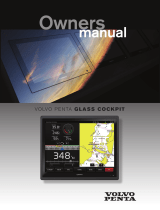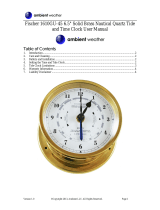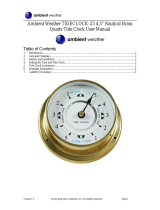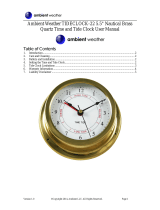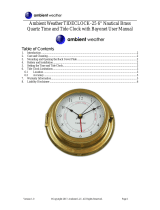Page is loading ...

GPSMAP
®
4000 Series
owner’s manual

© 2007 Garmin Ltd. or its subsidiaries
Garmin International, Inc.
1200 East 151
st
Street,
Olathe, Kansas 66062, USA
Tel. (913) 397.8200 or
(800) 800.1020
Fax (913) 397.8282
Garmin (Europe) Ltd.
Liberty House
Hounsdown Business Park,
Southampton, Hampshire, SO40
9RB UK
Tel. +44 (0) 870.8501241
(outside the UK)
0808 2380000 (within the UK)
Fax +44 (0) 870.8501251
Garmin Corporation
No. 68, Jangshu 2
nd
Road,
Shijr, Taipei County, Taiwan
Tel. 886/2.2642.9199
Fax 886/2.2642.9099
All rights reserved. Except as expressly provided herein, no part of this manual may be reproduced, copied,
transmitted, disseminated, downloaded or stored in any storage medium, for any purpose without the express prior
written consent of Garmin. Garmin hereby grants permission to download a single copy of this manual onto a hard
drive or other electronic storage medium to be viewed and to print one copy of this manual or of any revision hereto,
provided that such electronic or printed copy of this manual must contain the complete text of this copyright notice
and provided further that any unauthorized commercial distribution of this manual or any revision hereto is strictly
prohibited.
Information in this document is subject to change without notice. Garmin reserves the right to change or improve its
products and to make changes in the content without obligation to notify any person or organization of such changes
or improvements. Visit the Garmin Web site (www.garmin.com) for current updates and supplemental information
concerning the use and operation of this and other Garmin products.
Garmin
®
is a trademark of Garmin Ltd. or its subsidiaries, registered in the USA and other countries. GPSMAP®,
AutoLocate®, TracBack®, and BlueChart® are trademarks of Garmin Ltd. or its subsidiaries. These trademarks
may not be used without the express permission of Garmin.
April 2007 Part Number 190-00779-00 Rev. A Printed in Taiwan

GPSMAP 4000 Series Owner’s Manual i
IntroductIon
IntroductIon
This manual includes information for the following products:
GPSMAP
®
4008
GPSMAP
®
4208
GPSMAP
®
4012
GPSMAP
®
4212
Tips and Shortcuts
Press HOME from any screen to return to the Home screen.
Press MENU from any of the main screens to access advanced settings.
Press and release the POWER key to adjust the display settings.
Manual Conventions
In this manual, when you are instructed to select an item, press the SOFT KEY along the right
side of the screen to select each item. Small arrows (>) in the text indicate that you should press
the SOFT KEY for each item in order. For example, if you see “select Charts > Nav Chart,” you
should press the SOFT KEY next to Charts, Then press the SOFT KEY next to Nav Chart.
Quick Links
Turning the Unit On or Off: page 2.
Acquiring GPS Satellite Signals: page 3.
Inserting and Removing SD Cards: page 4.
Restoring Factory Settings: page 4.
Using the Navigation Chart: page 7.
Changing the Chart Settings: page 12.
Navigating to a Destination: page 23.
Creating a Waypoint: page 25.
Conguring System Settings: page 35.
Using Radar: page 43.
Using Sonar: page 49.
Using XM: page 53.
Alarms and Messages: page 63.
•
•
•
•
•
•
•
•
•
•
•
•
•
•
•
•
•
•
•
•

ii GPSMAP 4000 Series Owner’s Manual
IntroductIon
table of contents
Introduction ..........................................................................................................................i
Tips and Shortcuts ....................................................................................................................... i
Manual Conventions .................................................................................................................... i
Quick Links ................................................................................................................................... i
Warnings ..................................................................................................................................... iv
Important Information ................................................................................................................ iv
Getting Started ....................................................................................................................1
Unit Overview .............................................................................................................................. 1
Front and Rear Panels ................................................................................................................ 1
Power/Backlight .......................................................................................................................... 2
Acquiring GPS Satellite Signals ................................................................................................ 3
Inserting and Removing SD Cards ............................................................................................ 4
System Settings .......................................................................................................................... 4
Understanding the Home Screen ............................................................................................... 5
Using Charts .......................................................................................................................7
Using the Navigation Chart ........................................................................................................ 7
Using Mariner’s Eye ...................................................................................................................11
Changing the Chart Settings .................................................................................................... 12
Using BlueChart g2 Vision ....................................................................................................... 14
Using Mariner’s Eye 3D ............................................................................................................ 15
Using Fish Eye 3D ..................................................................................................................... 16
Using Fishing Charts ................................................................................................................ 16
Enabling High Resolution Satellite Imagery ........................................................................... 17
Viewing Aerial Photos ............................................................................................................... 18
Viewing Current Station Information ....................................................................................... 20
Detailed Road and POI Data ..................................................................................................... 20
Using Automatic Guidance ....................................................................................................... 20
Using Combinations .........................................................................................................21
Using Where To ................................................................................................................23
Navigating to a Destination ...................................................................................................... 23
Creating and Using Waypoints ................................................................................................ 25
Creating and Using Routes ...................................................................................................... 27
Viewing Information .........................................................................................................29
Viewing Tide Station Information ............................................................................................. 29
Viewing Current Information .................................................................................................... 29
Viewing Celestial Information .................................................................................................. 30
Viewing User Data ..................................................................................................................... 31
Viewing Information on Other Boats ....................................................................................... 32
Viewing Gauges ......................................................................................................................... 33
Viewing Video ............................................................................................................................ 34
Conguring the Unit .........................................................................................................35
Conguring System Settings ................................................................................................... 35
Changing Units of Measure ...................................................................................................... 35
Conguring Communications Settings ................................................................................... 36
Setting Alarms ........................................................................................................................... 37
Conguring My Boat ................................................................................................................. 38
Conguring Other Boats .......................................................................................................... 40
Conguring XM Audio ............................................................................................................... 40

GPSMAP 4000 Series Owner’s Manual iii
IntroductIon
Using the Marine Network ............................................................................................... 41
Viewing Connected Garmin Marine Network Devices ............................................................42
Using Radar ...................................................................................................................... 43
Understanding the Cruising Screen .........................................................................................44
Understanding the Radar Overlay Screen ...............................................................................47
Radar Setup ................................................................................................................................48
Using Sonar ...................................................................................................................... 49
Understanding the Full Screen .................................................................................................49
Understanding the Split Zoom Screen .....................................................................................49
Understanding the Split Frequency Screen .............................................................................50
Understanding the Temp Log ....................................................................................................50
Setting Up Sonar ........................................................................................................................51
Advanced Sonar Settings ..........................................................................................................52
Using XM WX Weather and Audio ................................................................................... 53
Using XM WX Weather ...............................................................................................................53
Setting the XM WX Weather Options ........................................................................................53
Viewing Precipitation Information ............................................................................................53
Viewing Forecast Information ...................................................................................................56
Viewing Sea Conditions .............................................................................................................57
Viewing Fishing Information .....................................................................................................58
Viewing Visibility Information ...................................................................................................59
Viewing Buoy Reports ...............................................................................................................59
Using XM Audio ..........................................................................................................................60
Appendix ........................................................................................................................... 61
Specications .............................................................................................................................61
Initializing Unit Settings .............................................................................................................62
Messages and Alarms ................................................................................................................63
Product Registration ..................................................................................................................66
Caring for the Unit ......................................................................................................................66
NMEA 0183 and NMEA 2000 ......................................................................................................67
FCC Compliance .........................................................................................................................68
Declaration of Conformity (DoC) ..............................................................................................68
Limited Warranty ........................................................................................................................69
Software License Agreement ....................................................................................................70
Index .................................................................................................................................. 71

iv GPSMAP 4000 Series Owner’s Manual
IntroductIon
Failure to avoid the following potentially
hazardous situations could result in an accident
or collision resulting in death or serious injury.
When navigating, carefully compare information
displayed on the unit to all available navigation
sources, including information from visual
sightings, and maps. For safety, always resolve
any discrepancies or questions before continuing
navigation.
•
Use the electronic chart in the unit only to
facilitate, not to replace, the use of authorized
government charts. Ofcial government charts
and notices to mariners contain all information
needed to navigate safely.
Use this unit only as a navigational aid. Do not
attempt to use the unit for any purpose requiring
precise measurement of direction, distance,
location, or topography.
•
•
WARNING: This product, its packaging, and its components contain chemicals known to the State of California
to cause cancer, birth defects, or reproductive harm. This Notice is provided in accordance with California’s
Proposition 65. See www.garmin.com/prop65 for more information.
Warnings
Important Information
MAP DATA INFORMATION: One of the goals of Garmin is to provide customers with the most complete and
accurate cartography that is available to us at a reasonable cost. We use a combination of governmental and private
data sources, which we identify in product literature and copyright messages displayed to the consumer. Virtually all
data sources contain some inaccurate or incomplete data. In some countries, complete and accurate map information
is either not available or is prohibitively expensive.
The California Electronic Waste Recycling Act of 2003 requires the recycling of certain electronics. For more
information on the applicability to this product, see www.erecycle.org.
Hg
- LAMP(S) INSIDE THIS PRODUCT CONTAIN MERCURY AND MUST BE RECYCLED OR
DISPOSED OF ACCORDING TO LOCAL, STATE, OR FEDERAL LAWS.
For more information go to:
www.garmin.com/aboutGarmin/environment/disposal.jsp.

GPSMAP 4000 Series Owner’s Manual 1
GettInG Started
GettInG
started
GettInG started
Unit Overview
To turn on your unit for the rst time, you will be asked to specify certain settings. For details, see
page 62.
Front and Rear Panels
Power
Range (+/-)
Rocker
Mark
Select
Home
Menu
Numeric keypad
Softkeys
SD card slot
Automatic
backlight sensor
Front - GPSMAP 4212 shown
NOTE: The GPSMAP 4008 and 4208 do not have a numeric keypad.
NOTE: Use the softkeys to navigate the menus on the GPSMAP 4000 series unit.
Power
connector
Marine video
connector
NMEA 2000
connector
NMEA 0183
connector
Garmin Marine
Network
connectors
GPSMAP 4212 shown - Back

2 GPSMAP 4000 Series Owner’s Manual
GettInG Started
GettInG
started
Power/Backlight
Press and hold the POWER key until the Garmin screen appears. When the Warning screen
appears, press SELECT to agree to the warning and proceed to the Home screen.
NOTE: The rst time you power on your unit, you must go through a setup sequence. See page 62
for details.
To turn the unit off, press and hold the POWER key.
Warning Screen
Home Screen

GPSMAP 4000 Series Owner’s Manual 3
GettInG Started
GettInG
started
Adjusting the Backlight
1. Press and release the POWER key.
2. Select Backlight.
3. To allow the unit to automatically adjust the backlight based on ambient light, select Auto.
To manually adjust the backlight,
either select Up or Down, or use
the ROCKER.
To return to the previous screen,
select Back.
Adjusting the Color Mode
1. Press and release the POWER key.
2. Select Color Mode.
3. Select Day, Night, or Auto.
Day colors are brighter and easier to read in sunlight, night colors are darker and more
subdued. The auto setting switches between day and night colors at sunrise and sunset
(based on almanac data).
Acquiring GPS Satellite Signals
When you turn the unit on, the GPS receiver must collect satellite data and establish its current
location.
When the unit acquires satellite signals, the signal strength bars at the top of the Home screen
are green . When the unit loses satellite signals, the green bars disappear and a ashing
question mark is displayed on the boat icon (on the chart screen).
For more information about GPS, visit the Garmin Web site at www.garmin.com/aboutGPS.
•

4 GPSMAP 4000 Series Owner’s Manual
GettInG Started
GettInG
started
Inserting and Removing SD Cards
Your unit supports Secure Digital (SD) cards. Insert optional BlueChart
®
g2 Vision
™
SD cards to
view high-resolution satellite imagery, and aerial reference photos of ports, harbors, marinas, and
other points of interest. Insert blank SD cards to transfer data such as waypoints, routes, and tracks
to another compatible Garmin unit or a PC. The SD card slot is located on the bottom-right corner of
the unit.
To insert the SD card, open the access door and press the SD card in until it clicks.
Card label
GPSMAP 4012 or 4212
Card label
GPSMAP 4008 or 4208
To remove the SD card, press in on the SD card. The card pops out.
For more information on BlueChart g2 Vision, see page 14.
For more information on transferring data, see page 31.
System Settings
The following paragraphs describe how to view system information, restore factory settings, and use
the simulator mode. For a more detailed description of system settings, refer to page 35.
Restoring Factory Settings
You can restore your unit to the original factory settings.
CAUTION: This procedure deletes any information you have entered.
To restore factory settings:
1. From the Home screen, select Congure > System > System Information.
2. Select Factory Settings.
3. Select Reset to restore all factory settings. Otherwise, select No to cancel.

GPSMAP 4000 Series Owner’s Manual 5
GettInG Started
GettInG
started
Viewing System Information
You can view your unit’s software version, basemap version, unit ID number, and your XM weather
Radio ID (if available). You may need this information to update the system software or purchase
additional map data information.
From the Home screen, select Congure > System > System Information.
Using the Simulator Mode
Simulator mode turns the GPS receiver off for use indoors or for practice. The unit does not track
satellites in simulator mode.
CAUTION: Do not try to navigate using simulator mode because the GPS receiver is turned off.
Any satellite signal strength bars shown are only simulations and do not represent the strength of
actual satellite signals.
To turn on Simulator Mode
1. From the Home screen select Congure > System > Simulator.
2. Select On to turn the simulator mode on. Select Setup to set speed, track control, position,
simulator time, and simulator date.
Understanding the Home Screen
Use the Home screen to access all other screens.
NOTE: Options on this screen vary based on the unit type.
Charts—access Navigation, Mariner’s Eye, Mariner’s Eye 3D, Fish Eye 3D, Fishing Charts
and Radar Overlay charts (page 7).
NOTE: Mariner’s Eye 3D, Fish Eye 3D, and Fishing Charts are available only if you use a
BlueChart g2 Vision SD card.
Radar—setup and view radar (page 43).
NOTE: The radar option is available only if you have a Garmin Marine Radar connected.
Sonar—access sonar information (page 49).
NOTE: The sonar option is available only if you have a Garmin sonar module connected.
•
•
•

6 GPSMAP 4000 Series Owner’s Manual
GettInG Started
GettInG
started
Weather—setup and view various weather parameters, including precipitation, forecast,
shing, sea conditions, and visibility (page 53).
NOTE: The weather option is available only if you have a Garmin XM Weather module connected.
Combinations—set up the screen to view a chart, sonar, radar, and video in a two or three
eld split screen (page 21).
Where To—access navigation features (page 23).
Information—view information including tides, currents, celestial data, user data,
information about other boats, gauges, and video (page 29).
Congure—view and edit unit and system settings (page 35).
•
•
•
•
•

GPSMAP 4000 Series Owner’s Manual 7
uSInG chartS
usInG
charts
usInG charts
The GPSMAP 4008 and 4012 units have a basic worldwide imagery map, and the GPSMAP 4208
and 4212 have built-in detailed BlueChart g2 cartography for the US shoreline.
Navigation Chart—displays all relevant navigation data available on your preloaded maps,
including buoys, lights, cables, depth soundings, marinas, and tide stations in an overhead
view.
Mariner’s Eye—a view from above and behind your boat for a visual navigation aid.
NOTE: If you are using a GPSMAP 4008 or 4012, you must insert an optional BlueChart g2 Vision
preprogrammed SD card to view detailed Navigation and Mariner’s Eye charts.
Fishing Charts and Fish Eye 3D views are available when using optional Blue Chart® g2 Vision™
preprogrammed SD cards (See page 14).
Fishing Chart—removes navigational data from the chart, while enhancing bottom contours
for depth recognition.
Fish Eye 3D—an underwater view that visually represents the sea oor according to the
chart’s information.
Using the Navigation Chart
Use the navigation chart to plan your course, view map information, and as a navigational aid.
NOTE: For GPSMAP 4008 or 4012 units, you must insert an optional BlueChart g2 Vision
preprogrammed SD card for your region to view detailed navigation charts.
To access a navigation chart, from the Home screen, select Charts > Navigation Chart.
Navigation Chart on a GPSMAP 4208
Buoy
Beacon
Your boat
Exposed
wreck
Marine
services
Zoom scale
Submerged
wreck
Zooming In and Out on the Map
The Range (+/-) keys control the zoom level, indicated by the scale at the bottom of the navigation
chart ( ). The bar under the number represents that distance on the map.
•
•
•
•

8 GPSMAP 4000 Series Owner’s Manual
uSInG chartS
usInG
charts
Navigation Chart Settings
To access additional settings or options for the navigation chart, press MENU.
Weather—turns the NEXRAD weather overlay on or off. This choice is only available when a
Garmin XM Network device is connected. See page 53 for more information.
Overlay Numbers—control how important numbers appear on the screen. Choose to show or hide
different numbers by category. Select Auto to show navigation, shing, and sailing numbers. When a
category is set to Auto, those numbers will only appear when that category is active.
Cruising: GPS position, GPS heading, GPS speed, and depth (Depth is only available if
connected to a sonar unit.)
Navigation: GPS position, distance, arrival (time), bearing (to destination), GPS heading, and
GPS speed. These numbers appear only when navigating to a destination (see page 23).
Fishing: GPS position, depth, water temp, and water speed (Depth, temp, and water speed are
only available when connected to a capable sonar unit.)
Sailing: GPS position, waypoint velocity made good (VMG), wind speed, wind direction,
water speed, and depth. (Wind speed and direction are only available when connected to a
capable NMEA 0183 wind sensor. Water speed and depth are only available when connected
to a capable sonar unit.) If you have a capable wind sensor, setting the sailing overlay
numbers to Auto places an indicator around the boat icon on the navigation chart to represent
wind speed and direction.
Chart Setup—customizes the navigation chart. See page 12.
Understanding Chart Data
BlueChart g2 and BlueChart g2 Vision charts use graphic symbols to denote map features. Some
common symbols you might see include, but are not limited to, the following:*
Dangerous Rock Exposed Rock Beacon
Pilot Boarding Area Airport/Seaplane Base Buoy
Anchorage Berth Precautionary Area Church
Anchoring Prohibited Radio Report Point
Exposed Wreck Recommended Anchorage
Fishing Harbor Rescue Station
Fishing Prohibited Tide Station
Information Yacht Harbor
Current Station Marine Services
*Some symbols might appear differently on your Garmin unit.
Other features common to most charts include depth contour lines (with deep water represented in
white), intertidal zones, spot soundings (as depicted on the original paper chart), navigational aids
and symbols, and obstructions and cable areas.
•
•
•
•

GPSMAP 4000 Series Owner’s Manual 9
uSInG chartS
usInG
charts
Panning the Navigation Chart
By pressing the ROCKER, use the map pointer ( ) to pan away from your current location, and
scroll to other areas on the navigation chart. As you pan past the edge of the current map display,
the screen scrolls forward to provide continuous map coverage. The position icon ( ) stays at your
present location. If the position icon leaves the map when you pan, a small window appears in the
corner so you can keep track of your current position.
As you move the map pointer, its coordinates, distance, and bearing from your current location
appear in the upper-left corner of the map.
To pan the map, press up, down, right, or left on the ROCKER.
Navigation Chart on a GPSMAP 4208
Map
pointer
Position
window
Pan
options
Pointer distance
and bearing
from current
location
Pointer
coordinates
To stop panning, select Stop Panning from the options on the right.
As you pan the map, a list of options appear along the right side. These options change as you move
the map pointer over various objects and charts. To access an option, press the corresponding soft
key:
Review—(may not appear if the pointer is not near an object - if the pointer is near only one object,
its name will appear instead of Review.) This allows you to view details of objects in the vicinity of
the pointer. When you select review, you are presented with a list of all the objects near the pointer.
See page 10 for more information.
Navigate To—allows you to begin navigation to the location of the pointer. For more information,
see page 23.
Create Waypoint—marks a waypoint at the location of the pointer. For more information, see
page 25.
Information—view tide station (page 29), current station (page 29), celestial (page 30), weather
(page 53), or chart information near the location of the pointer.

10 GPSMAP 4000 Series Owner’s Manual
uSInG chartS
usInG
charts
Accessing Additional Object Information
Use the map pointer ( ) to view information about on-screen map items, waypoints, and charts.
Select the rst option on the right with the object highlighted.
Object Selected on a GPSMAP 4208
Highlighted
object
Additional
object
information
Viewing Tide Station Information
Tide station information appears on the chart with a detailed icon showing the relevant tide level.
You can view an in-depth graph for a tide station to help predict the tide level at different times or
different days.
Relevant tide
level
Detailed
tide station
information
Tide Station Selected on a GPSMAP 4208
Use the map pointer ( ) to highlight a tide station icon ( ), and select Review for a detailed
tide graph. For more information about tides, see page 29.

GPSMAP 4000 Series Owner’s Manual 11
uSInG chartS
usInG
charts
Using Mariner’s Eye
Mariner’s Eye provides a view from above and behind the boat (according to your course), and
provides a visual navigation aid. This view is helpful when navigating tricky shoals, reefs, bridges,
or channels, and is benecial when trying to identify entry and exit routes in unfamiliar harbors or
anchorages.
To access the Mariner’s Eye screen, from the Home screen, select Charts > Mariner’s Eye.
Mariner’s Eye
Navigation Chart
The RANGE (+) key moves the view closer to your boat and lower to the water, while the RANGE
(-) key moves the view away from the boat. This is indicated by the scale ( ) at the bottom of
the screen.

12 GPSMAP 4000 Series Owner’s Manual
uSInG chartS
usInG
charts
Mariner’s Eye Settings
To access additional settings or options from the Mariner’s Eye screen, press MENU.
Rings—toggle the range rings on or off.
Tracks—turn the visible tracklog on or off. The unit continues to record tracks if you turn this
setting off, but they will be hidden from view.
Safe Depth—adjusts your boat’s safe depth.
Lane Width
—adjust the width of the course line drawn on the screen when navigating using Go To
navigation. This setting does not affect routes (Route To) or automatic guidance (Guide To).
Show Radar—
If you are connected to a Garmin Marine Radar through the Garmin Marine
Network, you can overlay your radar readings on the Mariner’s Eye screen.
Mariner’s Eye With Radar Information
Overlay Numbers—show or hide cruising, navigation, shing, and sailing numbers just as on the
navigation chart (page 8).
Changing the Chart Settings
To change chart settings, from the Home screen, select Charts > Chart Setup, or press MENU
while viewing the navigation chart and select Chart Setup.
Orientation—change the perspective of the map display:
North Up—sets the top of the map display to a north heading.
Track Up—sets the map display to the current track heading.
Course Up—sets the map so the direction of navigation is always up. The heading line will
appear vertically on the screen if it is shown.
•
•
•

GPSMAP 4000 Series Owner’s Manual 13
uSInG chartS
usInG
charts
Heading line
Track
Chart
border
Heading Line—draws an extension from the bow of the boat in the direction of travel.
Off—turns off the heading line.
Distance—sets the distance to the end of the heading line.
Time—sets the amount of time until you reach the end of the heading line.
Chart Borders
—turn on chart borders if you are using a BlueChart g2 Vision SD card and
you want to see what area the maps cover.
Tracks—hides (off) or shows (on) tracks on the chart.
Appearance—customizes how items are shown on the map.
Changing the Chart Appearance
From the Home screen, select Charts > Chart Setup > Appearance, or press MENU while
viewing the navigation chart and select Chart Setup > Appearance.
Detail—adjusts the amount of detail shown on the map at different zoom levels. The Most setting
will show the most detail at higher zoom levels, but the maps may take longer to draw. The Least
setting will not show map details until the lower zoom levels.
Photos—sets the high resolution satellite images to on, off, or land only. High-resolution satellite
imagery is only available while using a BlueChart g2 Vision SD card. See page 14 for more
information.
Spot Depths—turns on spot soundings and set a dangerous depth.
Light Sectors
—adjusts the drawing of light sectors on the map.
Symbols—selects the navaid symbol set (NOAA or IALA).
Symbol Size—adjusts the size of the symbols shown on the map.
•
•
•
•

14 GPSMAP 4000 Series Owner’s Manual
uSInG chartS
usInG
charts
Using BlueChart g2 Vision
Optional BlueChart g2 Vision preprogrammed SD cards allow you to get the most out of your unit.
In addition to detailed marine charting, BlueChart g2 Vision has the following features:
Mariner’s Eye 3D—a view from above and behind the boat, for a visual, 3 dimensional
navigation aid. The BlueChart g2 Vision Mariner’s Eye 3D is more detailed than the
preloaded data.
Fish Eye 3D—an underwater, 3 dimensional view that visually represents the sea oor
according to the chart’s information.
Fishing Charts—view the chart with enhanced bottom contours and without navigational
data. This chart works best for offshore deep-sea shing.
High Resolution Satellite Imagery—high resolution satellite images are provided for a
realistic view of the land and water on the Navigation chart.
Aerial Photos—view marinas and other navigationally signicant aerial photos to help you
visualize your surroundings.
Detailed Roads and POI data—view roads, restaurants, and other points of interest (POIs)
along the shore.
Current Data—view current station information.
Auto Guidance—uses the specied boat safe depth and chart data to determine the best
course to your destination.
Using the SD card
You can insert or remove a BlueChart g2 Vision SD card while your Garmin GPS unit is on or off.
Insert the SD card, label up, into the open SD card slot on your Garmin GPS unit and press in until it
clicks. Press in again to eject the SD card.
BlueChart g2 Vision SD cards are not waterproof. When the card is not inserted in the Garmin GPS
unit, keep it in the original packaging and store it away from exposure to sun and rain. BlueChart g2
Vision SD cards are susceptible to damage from static electricity. In low humidity environments, you
should ground yourself on a large metal object before handling the card.
Card label
GPSMAP 4012 or 4212
Card label
GPSMAP 4008 or 4208
NOTE: BlueChart g2 Vision data cannot be transferred from the SD card to your PC for backup or
viewing purposes. The SD card can only be used on BlueChart g2 Vision compatible Garmin GPS
units.
•
•
•
•
•
•
•
•
/
